| |||||
| Decades: | |||||
|---|---|---|---|---|---|
| See also: | |||||
Events in the year 1894 in Iceland .
| |||||
| Decades: | |||||
|---|---|---|---|---|---|
| See also: | |||||
Events in the year 1894 in Iceland .
Faroese is a North Germanic language spoken as a first language by about 72,000 Faroe Islanders, around 53,000 of whom reside on the Faroe Islands and 23,000 in other areas, mainly Denmark.

Iceland is a Nordic island country in the North Atlantic Ocean and in the Arctic Ocean. Iceland is the most sparsely populated country in Europe. Iceland's capital and largest city is Reykjavík, which is home to over 65% of the population. Iceland is the biggest part of the Mid-Atlantic Ridge that rises above sea level, and its central volcanic plateau is erupting almost constantly. The interior consists of a plateau characterised by sand and lava fields, mountains, and glaciers, and many glacial rivers flow to the sea through the lowlands. Iceland is warmed by the Gulf Stream and has a temperate climate, despite a high latitude just outside the Arctic Circle. Its high latitude and marine influence keep summers chilly, and most of its islands have a polar climate.

Scandinavia is a subregion in Northern Europe, with strong historical, cultural, and linguistic ties between its constituent peoples. In English usage, Scandinavia most commonly refers to Denmark, Norway, and Sweden. It can sometimes also refer more narrowly to the Scandinavian Peninsula, or more broadly to include all of Finland, Iceland, and the Faroe Islands.

Surtsey is a volcanic island located in the Vestmannaeyjar archipelago off the southern coast of Iceland. At 63.303°N 20.605°W Surtsey is the southernmost point of Iceland. It was formed in a volcanic eruption which began 130 metres below sea level, and reached the surface on 14 November 1963. The eruption lasted until 5 June 1967, when the island reached its maximum size of 2.7 km2 (1.0 sq mi). Since then, wave erosion has caused the island to steadily diminish in size: as of 2012, its surface area was 1.3 km2 (0.50 sq mi). The most recent survey (2007) shows the island's maximum elevation at 155 m (509 ft) above sea level.
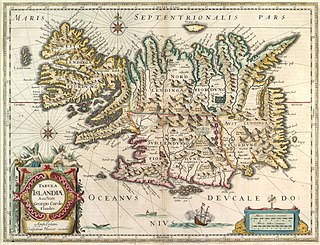
The recorded history of Iceland began with the settlement by Viking explorers and the people they enslaved from the east, particularly Norway and the British Isles, in the late ninth century. Iceland was still uninhabited long after the rest of Western Europe had been settled. Recorded settlement has conventionally been dated back to 874, although archaeological evidence indicates Gaelic monks from Ireland, known as papar according to sagas, had settled Iceland earlier.
The Social Democratic Alliance, officially The Alliance – Iceland's Social Democratic Party, is a social democratic, and pro-European political party in Iceland.

Icelanders are a North Germanic ethnic group and nation who are native to the island country of Iceland and speak Icelandic.
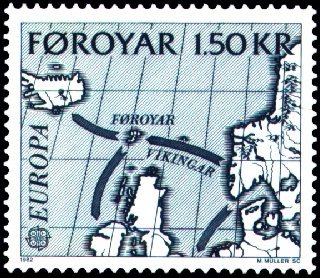
Naddodd was a Norse Viking who is credited with the discovery of Iceland.

Blönduós is a town and former municipality in the north of Iceland with a population of 895 in 2018. Like many towns and villages around Iceland, Blönduós did not emerge as a village until the late 19th century. The town is situated on Route 1 at the mouth of the glacial river Blanda. Hrútey [ˈr̥uːtˌeiː], a small island and natural reserve encircled by the river, is accessible via a pedestrian bridge just off the ring road. In 2022, the town merged with Húnavatnshreppur to form Húnabyggð.

Gunnbjörn Ulfsson, also Gunnbjörn Ulf-Krakuson, was a Norwegian settler of Iceland. He was reportedly the first European to sight Greenland. A number of modern place names in Greenland commemorate Gunnbjörn, most notably Gunnbjørn Fjeld.

Huldufólk or hidden people are elves in Icelandic and Faroese folklore. They are supernatural beings that live in nature. They look and behave similarly to humans, but live in a parallel world. They can make themselves visible at will. Konrad von Maurer cites a 19th-century Icelandic source claiming that the only visible difference between normal people and outwardly human-appearing huldufólk is, the latter have a convex rather than concave philtrum below their noses.

The Kingdom of Iceland was a sovereign and independent country under a constitutional and hereditary monarchy that was established by the Act of Union with Denmark signed on 1 December 1918. It lasted until 17 June 1944 when a national referendum established the Republic of Iceland in its place.

At the beginning of World War II, Iceland was a sovereign kingdom in personal union with Denmark, with King Christian X as head of state. Iceland officially remained neutral throughout World War II. However, the British invaded Iceland on 10 May 1940. On 7 July 1941, the defence of Iceland was transferred from Britain to the United States, which was still a neutral country until five months later. On 17 June 1944, Iceland dissolved its union with Denmark and the Danish monarchy and declared itself a republic, which remains to this day.
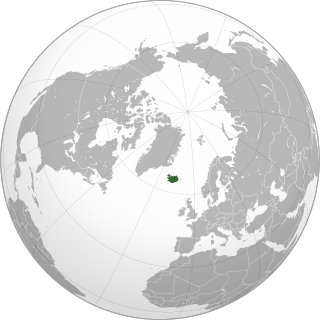
Icelandic is a North Germanic language spoken by about 314,000 people, the vast majority of whom live in Iceland, where it is the national language. Due to being a West Scandinavian language, it is most closely related to Faroese, western Norwegian dialects, and the extinct language, Norn.
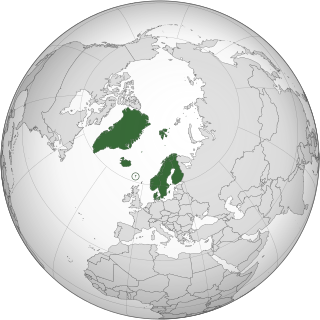
The Nordic countries are a geographical and cultural region in Northern Europe and the North Atlantic. It includes the sovereign states of Denmark, Finland, Iceland, Norway and Sweden; the autonomous territories of the Faroe Islands and Greenland; and the autonomous region of Åland.
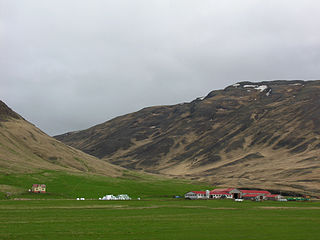
Skagabyggð is a municipality in Iceland. It surrounds the municipality of Skagaströnd. In June 2021, residents rejected a proposal to merge the municipality with the neighboring municipalities of Skagaströnd, Blönduósbær and Húnavatnshreppur.

Húnavatnshreppur is a former rural municipality located in northwestern Iceland.

The wildlife of Iceland is the wild plant and animal life found on the island of Iceland, located in the north Atlantic Ocean just south of the Arctic Circle. The flora and fauna is limited by the geography and climate of the island. The habitats on the island include high mountains, lava fields, tundras, rivers, lakes and a coastal plain of varying width. There is a long coastline, much dissected by fjords, especially in the west, north and east, with many offshore islets.
Ugla Stefanía Kristjönudóttir Jónsdóttir, also known as Owl Fisher, is an Icelandic journalist, filmmaker, author and non-binary trans activist.

Húnabyggð is a municipality in the north of Iceland, which was formed with the merger of Blönduós and Húnavatnshreppur. An vote was held in February 2022 where 97.8% of Blönduós inhabitants and 62.3% of Húnavatnshreppur inhabitants voted with the merge. The merger was finalized in the municipality elections in March 2022.